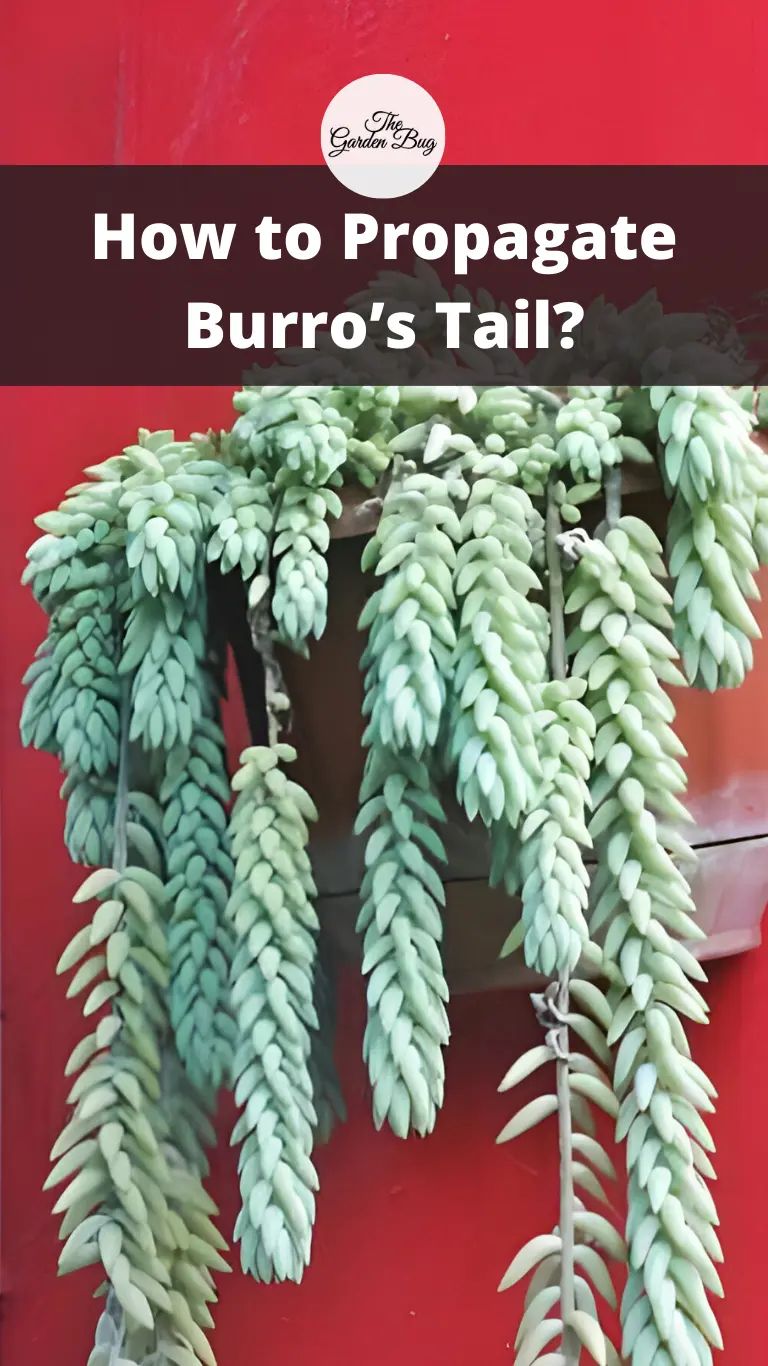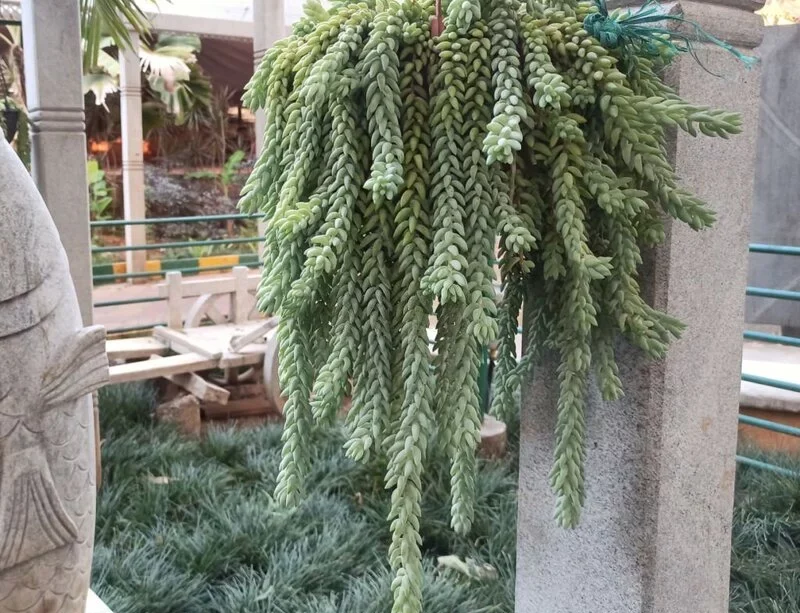If you’re a fan of succulents, you’ve probably admired the trailing beauty of a Burro’s Tail. These fascinating plants add a touch of whimsy to any space and, best of all, they’re surprisingly easy to grow. If you’ve ever wanted to have more of these beauties around, this guide is for you. We’re diving into the world of propagating Burro’s Tail!
- One Burro’s Tail Succulent Plant in 3.5′ Pot, Burrito Succulent
- Botanical Name: Sedum morganianum ‘Burrito’
- Zone: 10-11
- Exposure: Full Sun to Bright Filtered Light
- Soil: Well Drained
Burro’s Tail and Its Growth Habits
If we’re going to grow more Burro’s Tails, first we need to know a little bit about them. The Burro’s Tail, also known as Sedum morganianum or “donkey tail”, is a popular succulent, cherished for its unique trailing stems that are densely packed with teardrop-shaped leaves. It’s a slow grower, and over time, it can trail down several feet, creating a cascading effect that’s just mesmerizing.
Originally from Mexico, this plant loves lots of light and prefers well-draining soil, which mimics its natural desert habitat. It’s drought-tolerant and thrives in warm environments. One interesting fact about Burro’s Tail is how its leaves easily fall off. But don’t worry, this isn’t a sign of bad health. It’s actually a survival strategy and an easy way the plant propagates itself in the wild! In our next sections, we’ll learn how to use this feature to our advantage and create new plants.
When to Propagate Burro’s Tail
You might wonder when the best time is to start the propagation process. Well, the good news is that you can propagate a Burro’s Tail at any time of the year. However, the plant is actively growing during the warmer months (usually spring and summer), and that’s when it’s most likely to root successfully. So, for best results, try propagating your Burro’s Tail during these times. But remember, whether it’s winter, spring, summer, or fall, your Burro’s Tail can still give birth to a baby tail!
- FASTEST ROOTING POWDER FOR PLANT CUTTINGS: Hormex rooting hormone powder is a unique product that encourages the natural process of rooting new plants from cuttings. Please check the list of plant varieties and rooting powder strength in the product photos.
- SUITABLE FOR ALL GROW MEDIUMS: Accelerate strong and healthy roots with this root stimulator for plants that are excellent for all grow mediums like Rockwool, coco, peat moss, soil, clay pellets, and more. As an added bonus, it also helps prevent root rot and sagging cuttings.
- NO BAD STUFF: Our root hormone for cuttings is an excellent powder to use even on the toughest and hard-to-root plants, like juniper, grapes, tomatoes, and more. It is made with no alcohol, dye, or preservatives, which is especially important when plants are for consumption.
- EFFECTIVE FOR RAPID ROOT GROWTH: Hormex rooting compound consists of 1.60 percent Indole-3-Butyric Acid, a plant hormone ingredient that accelerates root formation. It is used on various plant varieties to promote a healthy root system for flowers, fruits, vegetables and more.
- EASY TO USE: Cut a 3″ – 6″ stem below a node at a 45-degree angle from a healthy plant. Dip in clean water or Hormex Liquid Concentrate. Coat 1″ of the wet end with Hormex Rooting Powder, tap off excess, and place in a Hormex Rooting Cube or similar starter medium. Manage temperature, humidity, and light for optimal growth.
Necessary Tools and Materials for Burro’s Tail Propagation
Before we jump into the propagation process, let’s gather our tools. You’ll be pleased to know that propagating Burro’s Tail doesn’t require any specialized gardening gear. Here’s what you need:
- A healthy Burro’s Tail plant (Parent plant): Check for a vigorous plant with no signs of disease or pests.
- A pot: Any small pot with a drainage hole will do. Remember, Burro’s Tail likes well-drained conditions.
- Potting mix: You’ll want a well-draining potting mix. A cactus or succulent mix is perfect for this.
- A flat surface: A clean tray or tabletop will do.
- Optional: Rooting hormone: This isn’t necessary, but can give your cuttings a boost to develop roots more quickly.
That’s it! With these simple materials, you’re well on your way to multiplying your collection of Burro’s Tail. Let’s get to it!
- Grows Plants Twice as Big vs. unfed plants
- Feeds up to 6 months
- More blooms for more color vs. unfed plants
- For indoor and outdoor container plants
- For use in containers
Step-by-Step Guide to Propagating Burro’s Tail
Let’s get into the action! Here’s a simple guide to propagate your Burro’s Tail:
- Choose and Remove a Leaf or Stem: Select a healthy leaf or stem from your parent Burro’s Tail. For leaves, gently twist and pull. For stems, use a clean, sharp knife or scissors to make a cut. Be gentle! You don’t want to crush or damage the plant parts.
- Let it Dry: Leave the cutting in a dry, shaded place for a few days until a callus forms over the cut area. This helps to protect it from rot when planted.
- Prepare Your Pot: Fill your pot with the cactus or succulent potting mix.
- Plant Your Cutting: Place the cutting on top of the soil for a leaf or insert the stem cuttings into the soil. Do not water it yet!
- Wait and Watch: Be patient! It could take a few weeks before you start to see little roots or new leaves developing.
- First Watering: Once you see roots, water the plant thoroughly. Remember, Burro’s Tail prefers to dry out fully between waterings, so don’t rush to water again!
Caring for the Newly Propagated Burro’s Tail
Congrats! You’ve brought a new baby Burro’s Tail into the world. Now, let’s make sure it grows up healthy and strong.
- Light: Place your young plant in a spot with bright, indirect light. Too much direct sunlight can scorch the leaves.
- Water: Remember the watering rule for Burro’s Tail: let it dry out between waterings. Overwatering is a common mistake, so when in doubt, wait a day or two before watering.
- Feeding: Feed your plant during the growing season (spring and summer) with a balanced, water-soluble fertilizer diluted to half strength. But don’t rush – start feeding only when your plant is established, which usually takes a few months.
- Potting On: As your plant grows, it might outgrow its pot. If roots start poking out of the drainage holes, it’s time to upgrade to a bigger pot!
There you have it, a new Burro’s Tail plant! Isn’t it exciting? Now, you can enjoy the satisfaction of watching it grow and thrive.
- SUPPORT NATIONAL FORESTS – For each bottle sold, we plant one native tree in America’s National Forests
- HEALTHIER PLANTS – Our optimized 3-1-2 formula will keep your houseplants as healthy as the day you brought them home.
- EASY TO USE – With simple directions and easy dispenser cap, keeping your houseplants healthy has never been easier.
- SUPER VERSATILE – Perfect formula for Christmas Cactus, Burro’s Tail, Jade Plants, Aloe Vera, Panda Plants, Zebra Plants, and all other succulents and cacti.
Troubleshooting Common Propagation Issues
Are you having some trouble with your propagation project? Don’t worry, it happens to the best of us. Let’s look at some common issues and how to fix them:
- Nothing’s Happening: If your cutting isn’t showing any signs of life after several weeks, it’s possible it may not have been viable. Not all cuttings will successfully root. Try again with a different piece.
- Cutting is Rotting: If your cutting is turning brown or black and getting mushy, it’s likely rotting, often due to overwatering. Start over with a fresh cutting, and remember, no water until you see roots!
- Leaves are Dropping: Burro’s Tail can drop leaves if it’s under stress. Ensure it’s in a location with appropriate light and stable temperatures.
Remember, patience is key when it comes to propagation. It’s a waiting game, but the results are worth it!
Conclusion
There you have it, everything you need to know to propagate your Burro’s Tail successfully! From taking your cuttings to planting and caring for them, you’re well-equipped to multiply your Burro’s Tail plants now. Remember, the most important thing is to have fun and enjoy the process. Each new growth is a testament to your nurturing and a wonderful addition to your indoor jungle.









